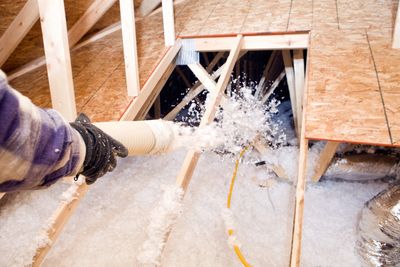Fiberglass Insulation

Types and Uses
The main types of fiberglass insulation that we use are batts and rolls, loose-fill, and rigid boards. Batts and rolls are the most common, while loose-fill requires specialized equipment for blowing into place. Rigid boards are used for areas like flat surfaces or where sound and moisture control are needed.
- Batts and Rolls:
- Batts: Pre-cut rectangular panels that are easy to install in standard framing spaces like walls, floors, and ceilings.
- Rolls: Available in long rolls, these are ideal for large, open spaces like attics and floors where you can cut the material to the required length.
- Loose-fill:
- Consists of small, loose fiberglass particles that are installed using a blowing machine.
- This type is best for filling irregular spaces and hard-to-reach areas like attics and existing wall cavities.
Blown-In Fiberglass (Loose-fill)
Blown Fiberglass insulation is made from molten glass that is spun or blown into fibers. Most manufacturers use 40% to 60% recycled glass content. Loose-fill insulation must be applied using an insulation-blowing machine in either open-blow applications (such as attic spaces) or closed-cavity applications (such as those found inside existing walls or covered attic floors).
Why Choose Blown-In Fiberglass?
- Enhanced energy efficiency: Blown-in insulation fills every nook and cranny, creating a continuous layer that's more effective at preventing air leaks than traditional batts. This reduces heat loss in winter and heat gain in summer, leading to lower energy bills.
- Moisture resistance: Fiberglass is naturally resistant to moisture and can act as a vapor barrier, helping to prevent mold and mildew growth and protecting against moisture-related damage.
- Fire resistance: The inorganic, non-combustible nature of fiberglass makes it a fire-resistant option, which adds an extra layer of safety to your home.
- Soundproofing: The density of blown-in insulation makes it highly effective at reducing noise transfer between rooms and from outside sources.
- Long-lasting performance: Fiberglass does not settle or deteriorate over time, ensuring its performance throughout the life of your home.
Blanket Insulation
Blanket insulation is a common type of insulation that comes in the form of flexible batts or rolls. It is made from materials like fiberglass, mineral wool, plastic fibers, and natural fibers. This insulation is designed to be installed between structural framing like wall studs, joists, and rafters in applications such as attics, floors, and walls
Why Choose Fiberglass?
- Energy-efficient: It can significantly reduce heating and cooling costs by minimizing heat transfer.
- Reduces noise: It acts as a sound barrier, blocking outside noise and reducing sound between rooms and floors.
- Improves air quality: Some types help balance moisture levels, and can also limit pests.
- Eco-friendly: Many products are made from recycled content, making them a sustainable choice.
- Fire-retardant: Many blanket insulation materials, like fiberglass and mineral wool, are naturally fire-resistant. Non-corrosive and non-combustible